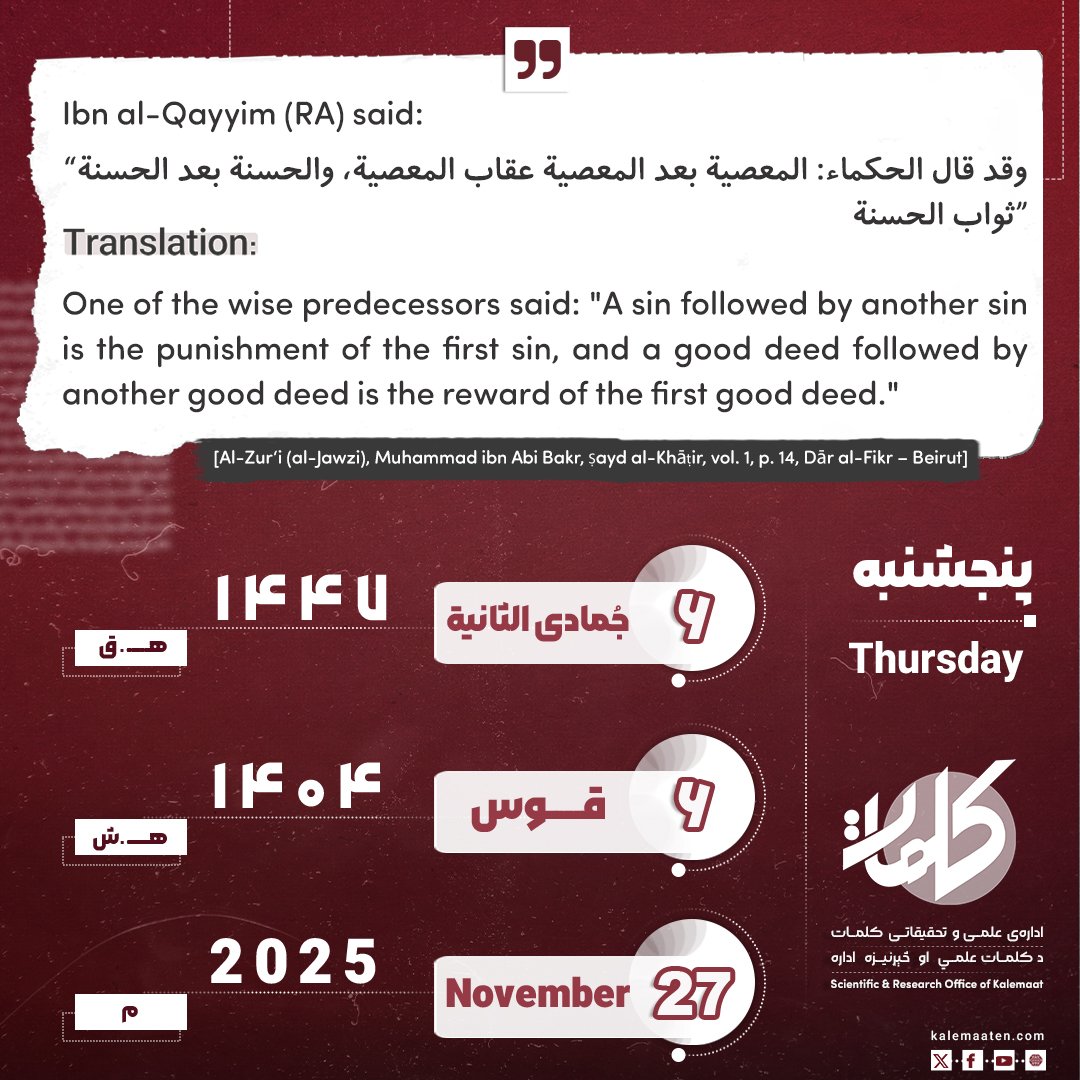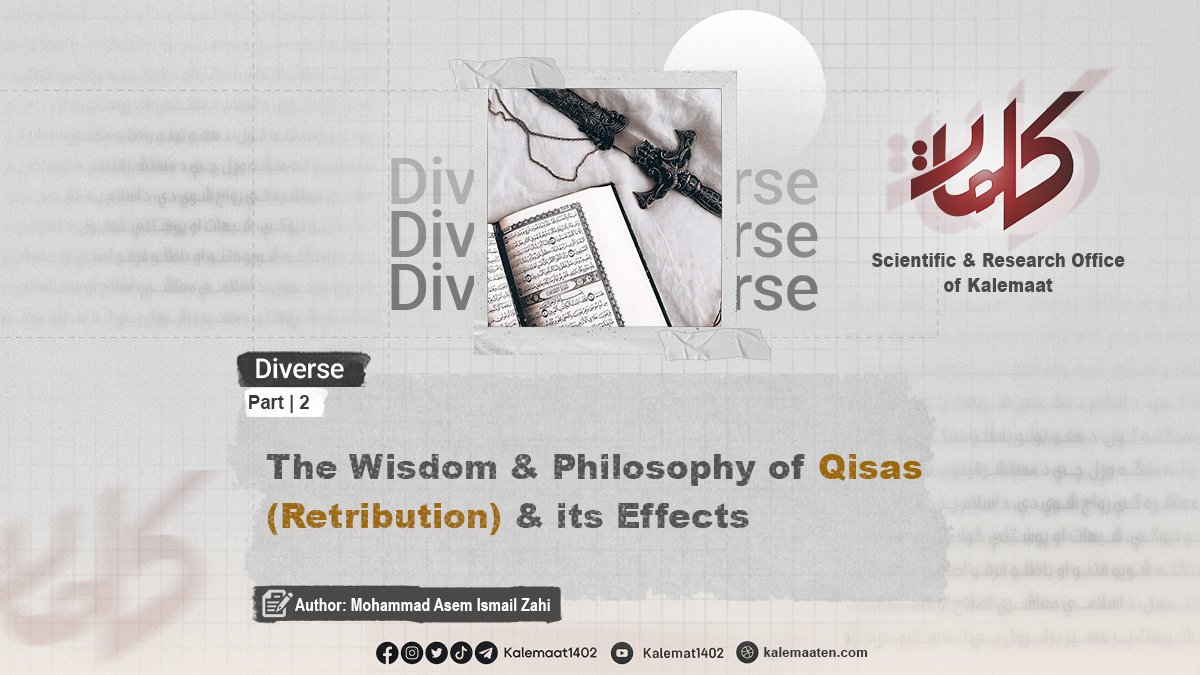Author: Mohammad Asim Ismail Zahi
The Wisdom and Philosophy of Qisas (Retribution) and Its Effects (part two)
Qisas in Language and Terminology:
Each scientific discipline has numerous specific terms established by the experts of that field. In fact, understanding concepts is considered the key to unlocking the mysteries of sciences.
1. Qisas in Linguistic Terms
The word Qisas is a verbal noun derived from the root qaṣṣa–yaquṣṣu (قصّ یقصُّ) which means “to follow the trace or sign of something.” [1]
Qisas, when pronounced with a kasrah under the letter “qāf” (qisas), means to give a person what they deserve for a sin or wrongdoing—killing a murderer, retaliation, punishment of the killer or assailant. [2]
Qisas refers to terminating a life based on ḥaqq al-‘abd (the right of the individual), and it is executed by the heirs of the victim in cases of intentional murder. [3]
Linguistically, qisas also means to follow the traces of something, as well as to act in accordance or similarity. [4]
In the same way, it implies giving retribution, such that a killer or an assailant is punished in the same manner—blow for blow, wound for wound. [5]
2. Qisas in Terminology:
Islamic jurists define qisas in a way that closely aligns with the linguistic meaning, but with a more restricted application. In jurisprudential terminology, qisas is confined to criminal matters, referring to punishing a criminal in the same manner as the crime they committed. If the person killed, they are to be killed; if they inflicted a wound, they are to receive a similar wound. [6]
Islamic jurists emphasize equality and similarity between the crime and the retaliatory action (qisas), and this is of fundamental importance. According to their definitions, if this similarity is not maintained, the act no longer qualifies as qisas.
Thus, if in a society people respond to a crime with collective violence and bloodshed, taking revenge on the offender or their tribe, it does not count as qisas. Likewise, if the consequences of a crime—like beating or wounding—are resolved through blood money (diyah) or forgiveness, or if a legal school permits pursuing a case only until compensation or pardon is achieved, such proceedings, though linguistically possibly termed qisas, are not qisas in the technical sense. [7]
According to Islamic criminal law scholars, qisas is essentially the application of an equivalent act against the criminal. In its implementation, one must not exceed the harm done to the victim. Otherwise, the legal and conceptual meaning of qisas would be lost.
Historical Roots of Qisas:
According to the Qur’an, the first crime of murder on Earth was committed due to the aggressive and egocentric nature of man. At that time, such an act was already considered a crime and sin. Human reactions to murder throughout history have varied depending on their level of awareness, culture, and intellectual development.
The emergence of religions and sects has influenced human lifestyles, eventually leading small communities to evolve into larger societies and states. These transformations in human society have also altered the way punishment is administered. Actions have been taken to ensure proportionality between crimes and their punishments, thus balancing individual and social reactions to crime to some extent.
To limit punishments and ensure proportionality, the concept of qisas was introduced. According to this principle, the punishment for a tooth is a tooth, and for an eye, an eye.
Revealed religions have played a major role in this process. This shift gave personal dimensions to responsibility and helped prevent collective punishment. Another impact of religion and sects was limiting or suspending punishment in certain times and places—for example, prohibiting warfare during specific occasions or halting punishments during festivals. [8]
In Judaism, qisas was implemented in two main ways: execution (stoning, burning, hanging, shooting, or cutting into pieces with a sword), which was applied in cases of intentional murder; and payment of diyah (blood money), often four or five times the inflicted damage, which applied to cases of unintentional killing. [9]
In the Gospel, the law of qisas is not clearly stated. Rather, it emphasizes forgiveness and mercy, which forms the core message of the Gospel and its followers. However, some believe that the law of qisas did exist in Christianity because the religion did not abrogate the Law of Moses (peace be upon him). [10]
In pre-Islamic Arab societies, the system of qisas was based on a tribal foundation. The tribe was held responsible for any crime committed by one of its members—unless the tribe officially expelled the killer and announced it publicly. Otherwise, the victim’s heirs would demand retribution not only from the murderer but also from other members of their tribe. This often led to excessive retaliation and full-scale tribal wars, especially if the victim was a nobleman or leader. In some tribes, these demands were overlooked, and the tribe would support the killer. [11]
Islam replaced these unjust acts of revenge with the fair law of qisas. On one hand, Islam shifted it from unregulated, emotion-driven behavior to a controlled legal framework under judicial authority. On the other hand, it transformed unjust revenge into just retribution (qisas), putting an end to the chaotic and disorderly legal state of the time. The act of killing multiple relatives of the murderer in response to a single death was a blind, irrational form of revenge that endangered many innocent lives.
Continues…
Previous Part/ Next Part
[1]. MirHosseini, Seyed Hassan, The Fall of Qisas, p. 15, Second Edition, Tehran, Mizan Publications, 2008.
[2]. Fekrat, Abdul Bashir, The Principle of Legality of Crimes and Punishments in Sharia and Complete Law, p. 91, Hamed Resalat Publications, 2016.
[3]. Stanekzai, Nasrullah and others, A Complete Glossary of Legal Terms, p. 197, Hamed Resalat Publications, 2008.
[4]. Nazir, Emdad Mohammad, General Criminal Law, p. 108, Second Edition, Kabul, Hamed Resalat Publications, 2020.
[5]. Mohammad Moin, Moin Dictionary, p. 2679, South of Tehran, Sepehr Publications, 2004.
[6]. Nazir, Emdad Mohammad, General Criminal Law, p. 108, Second Edition, Kabul, Hamed Resalat Publications, 2020.
[7]. Qiasi, Jalaluddin, A Comparative Study of General Criminal Law of Islam and Positive Law, vol. 1, p. 103, Publications of the Research Institute of Hauzeh and University, 2017.
[8]. Rasouli, Mohammad Ashraf, General Criminal Law, p. 110, Kabul, Publications: Vazheh, 2017.
[9]. Qiasi, Jalaluddin, A Comparative Study of General Criminal Law of Islam and Positive Law, vol. 1, p. 103, Publications of the Research Institute of Hauzeh and University, 2017.
[10]. Ibid., p. 105.
[11]. Al-Sayed Sabiq, Fiqh al-Sunnah (Hudud and Ta’zirat), p. 201, Translator: Mohammad Musa Hemmat, Kabul, Navida Publications, 1995.



